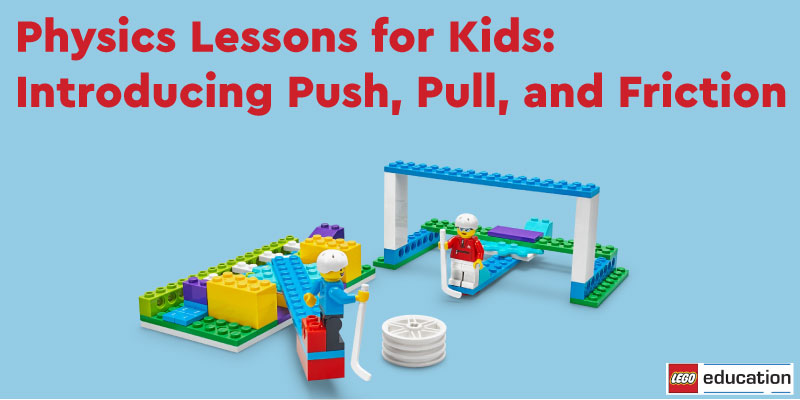Have you ever wondered why a car can stop when you press the brakes? These everyday occurrences are all made possible by fundamental physical forces. Among these, frictional force, push, and pull forces – play crucial roles in determining how objects move and interact in our world. Understanding these concepts is an important part of physics lessons for kids, helping them grasp the basic principles.
Understanding Frictional Force
The force that prevents one object from moving over another is called the frictional force. Frictional force mostly comes in two forms:
- Static Friction: The frictional force that stops an object from moving when it is at rest is known as static friction. It keeps the object in position until enough force is used to move it out of the way.
- Kinetic Friction: This kind of friction occurs when an object is moving already. Kinetic friction, in contrast to static friction, is often weaker, requiring less force to maintain motion than was required to start it.
Everyday Examples of Frictional Force
One of the essential forces at play in the world around us is frictional force, making it a key concept in physics lessons for kids. There is friction everywhere, and it has an impact on many daily tasks like:
- Walking: The friction created by your shoe and the ground keeps you from slipping when you stride. The friction that we experience makes walking almost impossible.
- Driving: When you press the brakes to your car, the friction between the road and the tires causes the car to gradually slow down and then eventually come to a halt.
- Writing: Did you know that when you write with a pen on paper, there is friction at play? Well, this phenomenon keeps the ink on the page and makes writing possible.
- Rolling a Ball: Rolling friction is when a wheel or ball moves across a surface. Rolling friction slows an object down even though it isn’t as strong as sliding friction.
Factors Affecting Frictional Force
Several factors determine the magnitude of the frictional force acting between two surfaces:
- Surface Characteristics: There is a direct correlation between surface roughness and inter-surface friction. The reason for this is that uneven surfaces allow for more tightly knotted patterns formed by bumps and ridges than flat ones.
- Normal Force: Pressing two surfaces together is known as the normal force. This is proportional to the weight of the object. Since the surfaces are compressed more firmly, a larger normal force causes more friction to exist.
- Relative Velocity: As the speed of movement increases, kinetic friction may slightly change, but it generally remains constant once motion begins. However, in fluid environments (like air or water), friction increases as velocity increases.
- Lubrication: The presence of a lubricant, such as oil or water, between surfaces, reduces friction by creating a thin barrier that separates them.
Push and Pull Forces
Although basic, push and pull forces are essential for moving objects. These forces, which are exerted in various directions, have the ability to accelerate, alter direction, or halt objects which is inevitable in physics lessons for kids.
- Push Force: A push force is a force that pushes anything away from its source. For example, you are using force to move a book ahead when you push it across a table.
- Pull Force: A pull force draws objects in the direction in which the force is applied. A pull force is applied to move a rope in your direction when you draw it towards yourself.
Newton’s Second Law of Motion, which states that force equals mass times acceleration (F = ma), describes how both push and pull forces operate. Assuming frictional effects are eliminated, an item will accelerate further with a greater applied force.
The Relationship Between Frictional Force and Push & Pull Forces
To understand how objects move, it’s important to know how push or pull forces work together with frictional force.
- Overcoming Friction: The push or pull force used must be greater than the static frictional force to move an object that is at rest. For this reason, once a heavy item is in motion, maintaining it requires less work than initiating it.
- Balanced Forces: Equal push and pull forces and frictional forces result in balanced forces, which cause an item to either stay at rest or move at a constant speed. In this equilibrium condition, the forces balance each other out.
- Net Force and Acceleration: An object experiences net force action, which accelerates it if the push or pull force is larger than the frictional force.
For instructing students on physics lessons for kids, the LEGO® Education BricQ Motion Essential Set is an excellent resource. Learners can observe these forces at work and understand how they impact mobility by creating an obstacle course for dogs.
FAQs Related to Frictional Force and Push & Pull Forces
- What makes static friction different from kinetic friction? Static friction stops stationary things from moving, whereas objects that are in motion the effects of kinetic motion in play.
- How can one lessen the force of friction? Reduce friction by using lubricants, smooth surfaces, or streamlined shapes.
- Why is friction relevant to day-to-day living? To walk, drive, and grasp objects firmly, friction is required. It makes movement controllable and keeps things from slipping.
The fundamental ideas of push, pull, and frictional forces affect almost every aspect of motion. Gaining a better understanding of these forces through physics lessons for kids, allows us to understand & solve real-world problems in various fields.

